The Continuing Acetonitrile Shortage: How to Combat it or Live with It
LCGC North America
Ron Majors provides an unbiased look at this present crisis and gives alternative solutions.
The worldwide shortage of the popular solvent acetonitrile started in the early fall of 2008. Many laboratories were caught unaware of this pending shortage and did not address the problem quickly enough while others who sensed the problem stocked up on the available supply at the time. Unlike methanol and other solvents that are manufactured for industrial use, acetonitrile is available only as a byproduct of another chemical production. Surprisingly, even the solvent companies, who supply high-grade acetonitrile, experienced a shortage of feedstock for their purification and, hence, could not obtain sufficient acetonitrile to address their customer needs, and the scramble was on. Prices have skyrocketed. Since last October, internet blogs and on-line chromatography forums have been discussing and debating the issue, even referring to the shortage as a "conspiracy of solvent companies." Depending upon the laboratory and the country reporting, there was more than a sufficient amount or none at all. Many ideas to handle the "short-term" shortage were floated around, some of which were practical, some of which were off-the-wall. Many of the ideas were generated by commercial entities, some of whom slanted the possible solution to suit their business needs. In this article, I will present an unbiased look at some of the more practical aspects of coping with the acetonitrile shortage. Currently, as of this writing, there is no prediction when normal supplies will resume.

Ronald E. Majors
Why is Acetonitrile So Popular?
Acetonitrile is a solvent that has favorable properties for many chemical applications. It shows minimal chemical reactivity, low acidity, and is reasonably low boiling. Important for reversed-phase high performance liquid chromatography (HPLC) and hydrophilic interaction liquid chromatography (HILIC) applications is its miscibility with water, wide range of achievable polarities with water mixtures, low viscosity (resulting in low pressure drop, even with water binary systems), and low ultraviolet cutoff (down to 192 nm). For HILIC, large volume percentages of acetonitrile in water are favored and thus, its use can be more affected by the acetonitrile shortage than reversed-phase chromatography. Particularly hard hit are those who do preparative- and process-scale LC purification using acetonitrile eluents. Acetonitrile is also a very popular solvent for sample preparation techniques such as dilution, protein precipitation of biological fluids, and as a good eluent for solid-phase extraction (SPE). Acetonitrile also finds use in solid-phase oligonucleotide–DNA synthesis, for peptide synthesis, and in the manufacturing of drug substances and drug products, sometimes in copious amounts. So there are many reasons why there is concern over limited supplies.
What Are The Reasons for The Shortage?
When first reported, there were a couple of reasons why the acetonitrile shortage arose so quickly. One of the first reports was that during the 2008 Summer Olympics, Chinese factories where acetonitrile was produced as a synthetic by-product were shut down to minimize air pollution. One of the plants was reportedly the largest producer of acetonitrile in China. Some of the factories have not returned to production. Secondly, the September 2008 Hurricane Ike in the Texas Gulf Coast temporarily shutdown one of the major producers in Texas. This facility also had planned a shutdown in production for a factory update and expansion in January 2009. To add to the problem, this company is reported to be in financial difficulty. But the general consensus is that the worldwide demand for acrylonitrile has decreased severely due to the economic downturn.
It turns out that acetonitrile is a minor by-product of the manufacturing of acrylonitrile using the Sohio process. About 2–4% of the Sohio process results in the formation of acetonitrile that is then removed and purified for further use. Most manufacturers of acrylonitrile incinerate this by-product as fuel rather than trying to reclaim it. So, there are a limited number of acrylonitrile producers who reclaim the acetonitrile.
Acrylonitrile has been used widely in plastic products such as polyacrylonitrile and acrylonitrile-butadiene-styrene (ABS) resins. These products are used in automobile manufacturing (bumpers and other parts), carpeting, acrylic and carbon fibers, luggage, small appliances, telephones, computer housings, and other industries. Obviously, the reduced purchase of cars, the housing slump, and purchase of other consumer products has decreased the demand for acrylonitrile-based plastics and production has been curtailed. There also have been reports of a decrease in demand due to acrylic fibers losing market share to polyester fibers. With a large amount of pharmaceutical manufacturing moving to China and India, some of the acetonitrile production will stay in Asia, and that could be another factor in influencing the worldwide availability of acetonitrile down the road.
Thus, because the amount of acetonitrile is proportional to the reduction in acrylonitrile production, there is currently a shortage of this widely used solvent, relative to a year ago. There are other synthetic routes to produce acetonitrile but many of them are not as economical as that obtained from the acrylonitrile process. However, there have been some reports that opportunistic entrepreneurs in China are considering starting production of acetonitrile by alternative methods.
What Are The Consequences of The Acetonitrile Shortage?
Referred to as "The Great Acetonitrile Shortage" or "The Great Acetonitrile Drought" thereby creating "Acetonitrile Anxiety," obviously, when a commodity product falls in supply and the demand still exists, there are going to be cost consequences. The current prices for high-quality and HPLC-grade acetonitrile have gone through the roof with quotes of over $1000 for a 4 X 4-L case fairly commonplace. Price gouging seems to be in fashion. Prices have risen by factors of 6–8 since the summer of 2008. Distributors and suppliers are allocating their available supplies to favored customers based upon their past purchases. In some cases, laboratory chemical suppliers have not been selling this solvent at all, especially to new customers. In some parts of the world, supplies are not even available and deliveries as long as six months have been quoted. In other places, supplies seem to be recovering and prices moderately reduced. The general feeling is that acetonitrile prices will never return to 2008 levels.
Besides price gouging, another consequence of the shortage is that a number of speculators are showing up on internet blogs offering large quantities of bulk acetonitrile of questionable or unknown purity. Most avoid such transactions that also could raise suspicions when importing large amounts of solvent from abroad.
Some feel that the acetonitrile crisis is a "wake-up" call and that laboratories should now develop short-term and long-term strategies to come up with alternative solvent systems. The movement to "greener" solvent systems or miniaturized liquid-phase chromatographic systems could be a positive outcome.
Those most concerned about the acetonitrile shortage are those who work in regulated laboratories, particularly in the pharmaceutical industry. The United States Food and Drug Administration has received many inquiries related to the shortage of acetonitrile, most of which revolve around substituting an alternative solvent to use to validated methods. Their comment on this issue can be found in reference (1). Basically, they have maintained their position that "regardless of the changes a firm makes to address the (acetonitrile) shortage, appropriate method validation and compliance with relevant good manufacturing practices (CGMPs) are necessary" (1).
The most obvious consequence is that many laboratories are looking for a continued supply to maintain their current methods. In the absence of meeting their acetonitrile demands, they are looking for alternatives that can solve their analytical or synthetic problems with a minimum disruption. We will now explore approaches that can be used to eliminate or minimize the use of acetonitrile in their laboratory. We will not address those who use large amounts of acetonitrile in their manufacturing or synthesis processes.
Methods to Reduce HPLC Use of Acetonitrile Based Upon Changing Column Dimensions or Particle Size
Shorter columns with the same internal diameter: Depending upon the resolution of your important analytes of your current method, you might be able to reduce the length of your column without sacrificing the method resolution requirements. Because column length (L) is proportional to analysis time (t), when you reduce the column length and keep the flow rate constant, the amount of solvent required is proportionally reduced. Thus, for an isocratic separation, cutting the column in half, separation time and solvent required is halved. However, there is a proportional loss in theoretical plates (N), but because resolution is proportional to N½, one does not sacrifice as much resolution as you might think and the separation might be sufficient.
However, for gradient elution, if one cuts the column in half, the gradient time must be reduced proportionally also. Otherwise, your method can be compromised. When changes are made in column length, column internal diameter, flow rate, the change from the initial composition to the final composition, and gradient time, conditions must be adjusted to satisfy equation 1. According to equation 1, which refers to the apparent k value for gradient elution (or k*), a change in length must be accompanied by a proportional change in gradient time (tg).

Where
k* = apparent k value in gradient elution
tg = gradient time (min)
F = flow rate (mL/min)
S = constant
ΔB = change in %B over gradient time
Vm = elution volume (min)
So, if the column length is decreased by a factor of two, then tg must be reduced to ½ to obey equation 1. If, in addition, one would choose to speed up the separation by an increase in flow rate by a factor of two, then tg would be further decreased by a factor of two. Such a twofold change in conditions can have a detrimental effect on resolution but it could be tested easily.
Shorter column with smaller particles: The use of smaller particles packed into shorter columns is the current trend in higher throughput LC. In this case, a reduction in length is accompanied by a proportional reduction in particle size to maintain separation efficiency and perhaps resolution as well. Because L ~ N, there is a loss of plates in going to shorter columns but N ~ 1/dp (where dp is the average particle diameter) and therefore, plates are increased to maintain the overall resolution. Figure 1 provides the separation of some xanthines as an example of increasing speed by simultaneously reducing the column length from 25 cm to 5 cm and particle diameter from 5 μm to 1.8 μm while keeping the flow rate and the column diameter the same. The separation time (t) and the solvent consumption are reduced proportionally with each reduction in L. For this example, the solvent consumption in Figure 1a was 12 mL, in Figure 1b, 4.5 mL, and in Figure 1c, a total of 2.3 mL. Here, the resolution remained more or less the same so there was no sacrifice in method performance but a fivefold solvent savings.
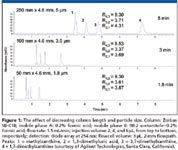
Figure 1
There is one caveat: as one decreases the particle size, there is a slight shift in the minimum of the van Deemter curve so that flow rate might have to be increased slightly to take full advantage of the particle size reduction. Thus, the separation time could be further decreased. The new submicrometer sized particles are particularly attractive here because separation times and reduction in solvent can be up to an order of magnitude compared to longer columns packed with larger particles. I have updated my listing of suppliers of 2-μm and sub-2-μm columns for high-throughput LC (Table I). With a visit to the websites of these companies, one can get method translation equations, calculators, and software to perform the necessary calculations for changing experimental parameters.
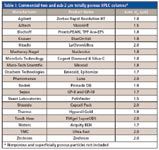
Table I: Commercial two and sub-2 μm totally porous HPLC columns*
The new superficially porous packings can provide some of the same advantages with the added benefit of lower pressure drops because column lengths are generally 5 cm and the particles are in the range of 2.7 μm, but the efficiencies noted are in the neighborhood of the sub-2-μm columns.
Reduction of the column internal diameter: An easy approach to reducing solvent consumption is changing the internal diameter of the column with or without decreasing the column length. According to equation 1, if one reduces the diameter and desires to keep the same separation time, the flow rate must be reduced proportionally to the inverse of the radius ratios squared. Thus, if a column internal diameter is reduced from 4.6-mm to 3.0-mm i.d. at constant length, then the flow rate would be reduced by (3.0/4.6)2 to a factor of 0.43. Thus, if one originally had a method using 1.0 mL/min and switched to the 3.0-mm i.d. column, the flow rate would be reduced to 0.43 mL/min and there would be resultant solvent savings of 57%. With 3.0-mm columns, almost any modern HPLC instrument could be employed because instrumental extracolumn volumes and gradient delay volumes are sufficiently small enough not to cause method variances. Decreasing column diameter with a concurrent decrease in flow rate (to maintain constant linear velocity) allows the separation time to remain constant, and users should see a very similar chromatogram as the original.
One can continue to reduce the column internal diameter and achieve further reductions in solvent usage. For example, changing from a 4.6-mm i.d. column to a 2.0-mm i.d. column (referred to as microbore or semimicro columns) will result in approximately 80% solvent savings without affecting the separation characteristics. Such a change can be seen in Figure 2, which shows a separation performed on a 4.6-mm column and a 2.1-mm column, both with a 150-mm length. The flow rate was reduced from 1.0 mL/min to 0.2 mL/min. Note that the sample size was reduced from 5 μL to 1 μL because the cross sectional area of the 2.0-mm column is 1/5. In the case of internal diameter reduction, the response increases fivefold if the sample size is injected. To keep the same response, the sample mass injected was decreased proportionally because a concentration-sensitive detector was used. If the same sample volume (at the same concentration) is injected onto the smaller internal diameter column, an increase in sensitivity should result (if no band spreading results from the larger injection volume), which makes microbore columns ideal for sample mass-limited situations.
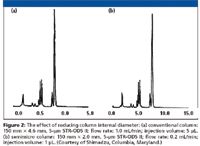
Figure 2
When one decreases the internal diameter of the column Vo, the column void volume decreases with the inverse radius ratio squared and peak volumes become smaller. Table II shows the approximate peak volumes at three different k values for three different column internal diameters at constant length. Note that for the smallest internal diameter column, 2.1 mm, the peaks with low k values are only a few tens of microliters in volume. For conventional liquid chromatographs, optimized for 4.6-mm i.d. columns, when peak volumes become less than 60 μL, some optimization of extracolumn effects (those volumes outside of the column packing) might be required (see highlighted values in Table II). Some of the hydraulic volumes that might need deceasing are injection volume, tubing volumes from the injector to the column inlet and from the column exit to the detector inlet (0.12–0.13 mm i.d. tubing is recommended), and the detector flow cell volume itself might need to be reduced if peaks with small k values are to measured. Because the flow rate for 2.0- or 2.1-mm i.d. columns is now much smaller, the gradient delay volume (sometimes referred to as the dwell volume which is the volume from the point of mixing of the gradient solvents to the head of the column) must be decreased. Otherwise, the gradient might take a considerable time to reach the head of the column and extrapolations from the larger column might not be entirely comparable.

Table II: Solvent saver columns can be used on most LC systems without modification (based on peak volume)
As the column internal diameter becomes further reduced to 1.0 mm and below, the system volume must be totally reworked. For this reason, most commercial chromatographs desired for capillary columns have extremely low extracolumn effects and gradient delay volumes including smaller flow cells as standard. In addition, they are designed to work well at flow rates below 100 μL/min.
To illustrate the effect of column internal diameter on solvent usage, peak volumes and flow rates, Table III provides some characteristics of such systems. Today, even nanoLC instruments that operate with extremely low flow rates (a few hundred nanoliters per minute) are available commercially but mostly are applied to proteomics, where samples are mass limited and mass spectrometry is primarily used for detection. These types of systems are the ultimate in solvent savings. With chip-based systems, a liter of acetonitrile could last a month or more!

Table III: Reducing column internal diameter reduces mobile phase use
Smaller internal diameter columns are often harder to pack as efficiently as larger diameter columns, so there can be some differences in plate number that might have some impact on extrapolations of separation data from larger internal diameter to very small internal diameter columns.
In the case of gradient elution, equation 1 still holds true. With a change in both length and internal diameter, both the flow rate and the gradient time will need to be adjusted. Remember, the column volume can be determined by V0 = 0.4 πr2 L, where r is the column radius and L is the length. To keep k* constant with the new column and the same gradient conditions, substitute the values for new column dimensions in equation 1.
Reduction of column internal diameter, column length, and particle diameter: Of course, one can combine these approaches to provide even more dramatic solvent savings. By such a combination, however, the column void volume can become quite small, necessitating optimization of the instrumental contributions as discussed previously.
Methods to Reduce HPLC Use of Acetonitrile Based Upon Changing Solvent or Stationary Phase
Use of other organic modifiers in reversed-phase HPLC: The most obvious change and one of the easiest to implement is to continue to use one's current reversed-phase column and change the organic modifier to a solvent more readily available. The most popular choice is methanol that can be obtained in high-purity suitable at a reasonable cost and is useful for most HPLC applications. Other solvents that have been considered are tetrahydrofuran, isopropanol, ethanol, and n-propanol. These solvents also are available in high purity for HPLC applications. Of these less commonly used organic modifiers, only tetrahydrofuran has some drawbacks, such as chemical stability — that is, peroxide formation for the unstabilized variety — or the presence of stabilizer, butylated hydroxyl toluene (BHT) that can interfere with UV detection and low UV transparency. However, tetrahydrofuran has some excellent solvation properties for polar analytes and is quite effective when blended with small amounts (~5–10%) of methanol. In addition, tetrahydrofuran can be blended to get approximately the same solvent strength (ε0) as acetonitrile. A mixture of 50% methanol, 25% tetrahydrofuran, and 25% acetonitrile works as a substitute for 100% acetonitrile
Methanol has some disadvantages for HPLC use when compared to acetonitrile. Due to its higher viscosity, the column pressure drop will increase. The well-known viscosity versus % methanol in water curves show a maximum viscosity at approximately 45% methanol while acetonitrile–water mixtures show a much lower increase in viscosity as the % acetonitrile increases. So when gradients are run with water–methanol binary solvents, pressures can increase and can approach the maximum operating pressure of the LC system. When substituting methanol for acetonitrile and operating at the same experimental conditions, the higher viscosity of methanol will give lower efficiency and can lead to slightly broader peaks. Methanol shows a higher UV cutoff (~210 nm) than acetonitrile (~192 nm) that limits its usefulness in the low UV region. Probably the biggest factor that one might observe when switching from acetonitrile to methanol is the different analyte selectivities that can occur (see Figure 3, reference 3). The most glaring change was the elution order of these compounds when using acetonitrile as the organic modifier (Figure 3a) compared to methanol (Figure 3b) as a modifier. Not only did the elution order change but peaks 4 and 6 that were well resolved with the acetonitrile–water solvent system were unresolved when methanol–water was used as the mobile phase. Because methanol is a weaker solvent than acetonitrile, note that its percentage had to be increased to have similar retention times. In Figure 3b, one can see that the methanol concentration in the binary mixture was 58% compared to the 39% acetonitrile shown in Figure 3a.
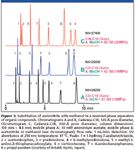
Figure 3
For binary mixtures of water and organic modifiers, a useful nomograph is shown in Figure 4 (4). This figure compares the approximate solvent strength of binary mixtures of water with the popular solvents acetonitrile, methanol, and tetrahydrofuran. Vertical lines in this figure intersect mobile phases having a similar solvent strength. For example, the vertical line at 40% tetrahydrofuran in water intersects the methanol line at 63% and the acetonitrile line at 53%. Thus, to get approximately equivalent retention times (or at least a similar solvent strength), these amounts of organic modifier would have to be blended with water. Thus, tetrahydrofuran is a more powerful modifier than acetonitrile that in turn is more powerful than methanol. If one closely compares the chromatograms of Figures 3a and 3b, it can be seen that the nomograph is only approximate. In addition, this nomograph does not predict selectivity changes, as was noted in Figure 3, nor are the nomographs suitable for ternary mixtures.

Figure 4
A slightly different format was used in Figure 5. Here, a plot that correlates the composition of several water-miscible solvents that could be used to replace acetonitrile is shown (5). This graph adds ethanol, isopropanol, and dimethyl sulfoxide (DMSO) that could be used as modifiers. Both isopropanol and DMSO are quite viscous, so one must carefully observe the column pressure when switching to such solvents. Again, this plot should be used as a starting point in the evaluation of a modified method.
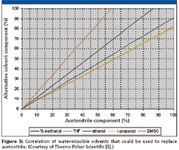
Figure 5
For HILIC applications, acetonitrile can be replaced with various alcohols. A nice study on comparing various alcohols as weak eluents in HILIC was published recently (6). In this study, the mechanism of HILIC was investigated through the method development for the analysis of trace amounts of polar and basic hydrazines. Separation parameters such a type and concentration of alcohol, acid modifier, and buffer in the mobile phase as well as choice of stationary phase and column temperature were studied.
Another action to reduce the use of acetonitrile is to use a different wash solvent to remove undesired compounds from the HPLC column. For example, some methods require a postgradient flush to remove highly retained substances before column regeneration. This flush is often accomplished using 100% acetonitrile for a period of time. The solvent used is directed to waste. Why not try an alternative solvent such as methanol or isopropanol to accomplish the same mission? Ternary and quaternary HPLC gradient systems can be programmed for this automatic flush. One would have to check out and verify this procedure to make sure that this alternate washing is as effective and to make sure that the column returns to it original condition after regeneration.
Changing the type or amount of stationary phase: By using a less hydrophobic stationary phase or the same stationary phase with a lower surface coverage, retention of organic analytes is decreased generally. Retention time is proportional to the amount of stationary phase that is available to the solute. For example, switching from a C18 to a C8 or even a C4 phase can cut down on the amount of organic modifier in the reversed-phase mobile phase and still achieve the same retention time. For C8, selectivity is often comparable to C18 but as the chain length decreases below C8, interactions with the silica surface might modify the selectivity.
Some suppliers do have reversed-phase chromatography columns with different amounts of the same stationary phase. Often, one can look at the column catalogs or spec sheets and determine the coverage specified. Bonded-phase coverage can be depicted as micromoles per square meter or as the percent carbon (%C). In both cases, the surface area of the base silica must be considered. A low %C on a high surface area silica might mean that there are surface silanols present and such columns can give a different selectivity compared to a column with low %C on a lower surface area silica base. A high %C also can mean that the bonded phase is polymeric and that phase might behave quite different from your original phase.
The most common way to reduce surface area is to use a wider pore diameter silica. In fact, Figure 3c shows the use of a wide pore (300 Å) silica that has a lower surface area than the smaller pore size silica used in Figures 3a and 3B. The pore diameter of the latter silica is 120 Å. Observe the % methanol used in Figure 3c compared to Figure 3b. A lower concentration of methanol was used in Figure 3c to achieve about the same overall separation time. In addition, peaks 4 and 6 that were unresolved on the higher coverage bonded phase are now well resolved to baseline. The efficiencies of all three columns were roughly equivalent but selectivities were all different either due to the organic modifier used or the C18 bonded phase coverage.
Methods to Reduce HPLC Use of Acetonitrile Based Upon Changing Experimental Conditions
Use of Increased Column Temperature: The use of temperature as a separation variable has become important in the last few years (7). One of the main drivers in employing higher temperatures is the increased use of ultrahigh-pressure liquid chromatography (UHPLC). Increasing the temperature will decrease the mobile phase viscosity and therefore allow the use of lower pressure to push solvent through sub-2-μm columns. Besides lower operating pressure, other benefits of high temperature are
- Increased efficiency
- Decreased analyte retention
- Potential for use of higher flow rates
- Changes in selectivity (could be positive or negative effect)
- Increased analyte sensitivity
Of course, there is always the danger of analyte instability at high temperatures but with the fast UHPLC columns, residence time is often quite short, only a few minutes, so that analytes are not exposed to high temperatures for long periods.
So, how does high temperature lessen the need for organic solvents, including acetonitrile? In reversed-phase chromatography, when a compound is eluted earlier at a higher temperature, decreasing the amount of organic modifier will increase its retention time back to its original value. Or alternatively speaking, as the temperature is increased, separation time decreases. Correctly speaking, van't Hoff plots (log k vs. 1/T, where T is the temperature in degrees Kelvin) show a positive slope for most compounds but the plots for all compounds might not be parallel, meaning that selectivity is sometimes affected.
The effect of temperature on retention is observed clearly in the simple example in Figure 6, where column temperature is increased systematically from ambient to 60 °C. Retention time and pressure decrease with each increase in temperature. A lower pressure allows one to increase the flow rate to increase the separation speed even more (see offset box in Figure 6, where the lower pressure allowed the flow rate to increase by 50%). Note that in Figure 6 there is a decrease in peak width with increased temperature, so column efficiency also benefits.
Modern HPLC ovens can easily achieve 90–100 °C and some are available that can operate up to 200 °C. One must take some care with the use of bonded silica columns at the higher operating temperature, especially as the pH of the mobile phase increases. Most silica reversed-phase chromatography columns can operate to about 70 °C and some to 90 °C. A few are reported to work even higher. The use of these higher temperatures has spawned the development of new high-temperature phases including those based upon bridged ethyl hybrids, polymeric, zirconia, graphitized carbon, and others.
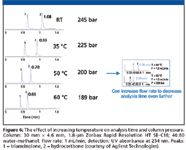
Figure 6
As shown previously, as the temperature of a two-phase water–organic system increases, retention decreases or alternatively, one can decrease the amount of organic and maintain retention; thus, solvent is saved. For pure water, an interesting phenomenon occurs as one goes to much higher temperatures. Increasing the water temperature from 25 °C to 250 °C gives decreases in solvent polarity, surface tension, and viscosity and provides solvation behavior resembling organic solvents such as methanol and acetonitrile (7). Indeed, one can use temperature programming to simulate a water–acetonitrile gradient without the presence of any organic solvent. With the advent of new phases capable of operation up to 200 °C and beyond, the use of pure water as a mobile phase brings about a true "green" analytical technique. To illustrate this impact, Figure 7 shows a separation of purines and pyrimidines using conventional conditions and using superheated water as an eluent. The column is packed with Hypercarb (Thermo Fisher Scientific, Waltham, Massachusetts), which is a porous graphitic carbon material with a 5-μm particle size. This column can withstand temperatures in excess of 200 °C. Figure 7a shows an isocratic separation of these six compounds using 85:15 (v/v) 0.1% formic acid–acetonitrile at a temperature of 50 °C. The separation is acceptable but there was some evidence of tailing, especially for peak 5. By increasing the temperature to 190 °C (Figure 7b) and using pure water, the entire isocratic separation was achieved in less time at a higher flow rate but without the need for acetonitrile in the mobile phase. The separated peaks showed good symmetry. Thus, superheated water chromatography is also a "green" method employing no organic solvent.
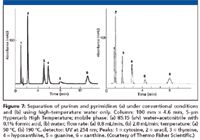
Figure 7
Make a pH change for ionizable compounds: Sometimes when ionizable compounds are separated in their nonionized form by reversed-phase chromatography, their retention times can be quite long, necessitating a higher percentage of organic modifier to elute them in a reasonable time. A change in pH below their pKa for bases and above their pKa for acids might be just the trick to remove them from the column more rapidly thereby saving organic solvent. The pH could be changed using a third solvent in a ternary or quaternary gradient system so that the original binary solvents do not have to be changed.
Alternative Technologies to Lower Amount of Acetonitrile Usage
Supercritical Fluid Chromatography: The supercritical fluid chromatography (SFC) technique has been around several decades and most recently has found strong application in the chiral separations arena, especially for preparative work. SFC significantly reduces organic solvent usage and waste by using carbon dioxide as the mobile phase and, thus, has a "green" technology label. Commercial instrumentation is available, including one accessory that readily can convert a conventional HPLC system to an SFC-capable one. Supercritical carbon dioxide exhibits liquid-like densities and can be pumped like a liquid as long as the system is held at the proper pressure and temperature conditions to maintain the supercritical state. Supercritical carbon dioxide has very low viscosity and is highly diffuse, enabling fast and highly efficient separations, often exceeding those of HPLC. SFC could be envisioned as a subset of normal-phase HPLC because carbon dioxide is a nonpolar eluent, even at high density. To increase its polarity, the supercritical fluid must be doped with an organic solvent, such as methanol, but usually at the less than 30% level. Columns used in SFC are much like those used in normal-phase HPLC such as cyano and amino, but SFC-specific stationary phases have been developed that provide even better selectivity, like 2-ethyl pyridine. Although traditionally thought of as a technique for nonpolar compounds only, SFC has been applied to cationic and anionic compounds, proteins, drugs, and as mentioned previously, chiral compounds. SFC can be interfaced to most detection systems including mass spectrometers with the only caveat being the requirements of a high-pressure flow cell or a back-pressure regulator and flow splitter at the exit of the column. Of course, an existing HPLC method would have to be completely redone and, thus, SFC is a disruptive technology for most laboratories. Nevertheless, SFC could be a strong competitor to HPLC for certain applications and the reduction of organic solvent used in SFC is significant.
Solvent recycling: Applicable to isocratic work only, solvent recycling can be an alternative in reducing the use of acetonitrile. In many isocratic applications, there are "dead spots" in the chromatogram where pure mobile phase only is flowing through the detector. In most laboratories, this effluent is directed to the waste bottle. In a solvent-recycling system, during times when there are no peaks being eluted, the solvent is diverted from the detector exit by means of a switching valve to a collection bottle or back into the reservoir. Thus, the spent mobile phase can be reused, thereby extending its useful life.
Traditional recycling systems used a fixed voltage level (or threshold above baseline) that had to be exceeded before a peak was detected. After a peak was detected, the solvent valve was directed to waste. If baseline drift would occur, then a new setting was required before the unit properly work. Modern recycling systems are now microprocessor-controlled and incorporate a peak sensing algorithm to more accurately detect peaks in the eluent making sure that all contaminants are eliminated, even if the system or detector conditions cause baseline drift. Thus, the maximum amount of uncontaminated solvent is collected for reuse. Solvent cost and disposal costs are minimized by recycling.
Distillation of spent solvent: Very seldom is pure acetonitrile used as a mobile phase in reversed-phase chromatography. Most often, the solvent is used in a binary system with water or buffered water so that the column effluent contains a mixture of solvents. Thus, it might be surmised that one could reclaim the acetonitrile by a simple or fractional distillation because the boiling points of water and acetonitrile are different. Not so! It turns out that acetonitrile forms an azeotrope with water and one ends up with a constant boiling mixture of acetonitrile containing 14% water (or more correctly 2.253 mol of acetonitrile for each mole of water) that boils around 76.5 °C. If one can ensure that the distillation conditions are strictly controlled, a purified mixture of 86% acetonitrile: 14% water could be collected and used as a "B" solvent in a binary gradient system.
A look at phase diagrams of water–acetonitrile at different pressures shows that the composition of this azeotrope can be affected by variations in pressure. Reduced pressure distillation would provide a higher organic content but the acetonitrile would still contain water. It might be difficult to control accurately the pressure during this type of distillation so that the composition can vary. There have been some suggestions to use a drying agent to remove the last traces of water but undoubtedly there can be some volatile compounds that also might distill during the process. There have been some entrepreneurial chemists who might be able to reclaim acetonitrile on a large scale but most likely this approach is beyond the capability of most chromatography laboratories.
Conclusions
I have tried to provide some suggestions on reducing the amount of acetonitrile and organic solvents in general in the HPLC laboratory. Obviously, many of these suggestions could be implemented together at once to minimize solvent usage greatly. With the exception of SFC, none of the suggestions require one to purchase a new instrument, although high-temperature ovens might not be available in most laboratories. Changing regulated methods might require more attention and investigation because agencies such as the FDA or U.S. Pharmacopeia have strict guidelines about changing column dimensions and experimental conditions without a full revalidation. In this installment, I did not cover the use of acetonitrile in sample preparation, which is another area where this solvent is used in significant amounts. This could be the subject for another day if the "Great Acetonitrile Shortage" continues.
Ronald E. Majors
"Column Watch" Editor Ronald E. Majors is business development manager, Consumables and Accessories Business Unit, Agilent Technologies, Wilmington, Delaware, and is a member of LCGC's editorial advisory board. Direct correspondence about this column to "Sample Prep Perspectives," LCGC, Woodbridge Corporate Plaza, 485 Route 1 South, Building F, First Floor, Iselin, NJ 08830, e-mail lcgcedit@lcgcmag.com.
References
(1) http://www.fda.gov/cder/ops/Acetonitrile_Shortages_FINAL_updated.pdf
(2) http://www.shimadzu.com/products/lab/5iqj1d0000003bt3.html
(3) Imakt Technical Information No. TI476E-IA17, 2009, Silvertone Sciences, USA.
(4) Sigma Aldrich Technical ReportT409034, 2009.
(5) (Thermo Fisher Scientific Chromatography Resource Center, "Substituting ACN with Another Solvent," www.separatedbyexperience.com
(6) M. Liu, J. Ostovic, E.K. Chen, and N. Cauchon, J. Chromatogr. A 1216(12), 2362-2370 (2009).
(7) Y. Yang, LCGC Eur. 16(6a), 37–41 (2003).
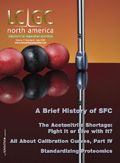
New Study Reviews Chromatography Methods for Flavonoid Analysis
April 21st 2025Flavonoids are widely used metabolites that carry out various functions in different industries, such as food and cosmetics. Detecting, separating, and quantifying them in fruit species can be a complicated process.

.png&w=3840&q=75)

.png&w=3840&q=75)



.png&w=3840&q=75)



.png&w=3840&q=75)











